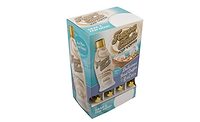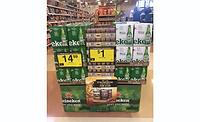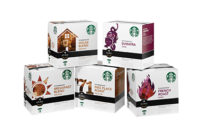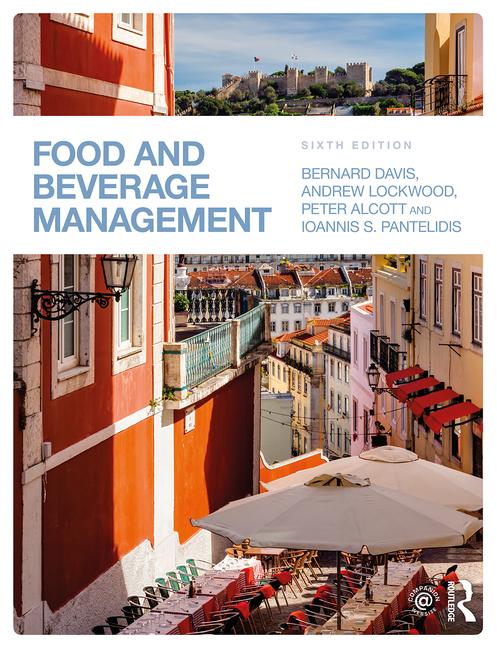Category management leverages insights
Technology, research provide retail solutions
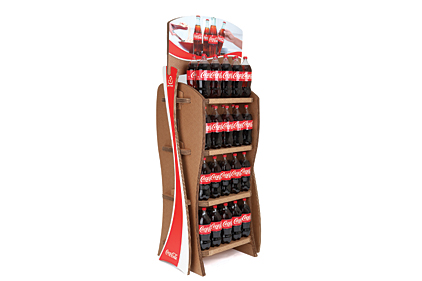

|
|
The Coca-Cola Co. has created a variety of retail options, including the recyclable Give It Back retail rack made from corrugated cardboard, to allow for placement of its products throughout a retail outlet. |
When it comes to category management, retail experts often agree that beverage manufacturers are on the leading edge of understanding assortment and placement of their products within retail outlets. Paul Weitzel, managing partner at Willard Bishop, Barrington, Ill., attributes part of the segment’s success to the direct store distribution (DSD) system used by many manufacturers.
“The advantage that we have in beverages for category management is that we have this DSD force out there who can mobilize to get things changed a lot quicker than sending a re-sort team to do the work,” Weitzel says. “They are there every week touching the shelf, so we can leverage them. I think that’s a huge advantage.”
Despite the praise, additional potential exists for beverage-makers to capture more consumers and purchase occasions at retail. Technological advancements have increased access to data that will help category managers better understand consumer shopping behaviors and responses to promotions.
Although the prevalence of data presents an upside, Gordon Wade, chief executive officer of the Category Management Association (CMA), Wimberley, Texas, says category managers continue to face challenges from SKU proliferation, new products and emerging categories, such as single-cup coffees.
Nearly 20 years ago, Wade co-wrote a best practice algorithm for the consumer packaged goods category. The algorithm was organized around the concept of transferable demand, which is the principle that shoppers will not walk out of a store if all the desired attributes are available in reasonable numbers, Wade explains.
The algorithm continues to be applicable across categories, including the growing selections of beer and coffee, he says. “As is the case with craft beers and some carbonated soft drink SKUs, little justification exists for multiple SKUs of French vanilla coffee from four different brands,” Wade says. “In a large number of instances, we are confident that volume is easily transferable among virtually identical SKUs.”
Todd Bradley, partner with The Partnering Group (TPG), Cincinnati, agrees that as consumer shopping behaviors change, a careful approach to assortment continues to be relevant.
“People are shopping less frequently, spending less time per trip, and are less and less satisfied with each shopping occasion,” Bradley says. “To improve sales, it is critical that the shopping occasion be easier and more enjoyable. That starts with simplifying — many studies have proven that less is often more. Less SKUs in many categories translates to more sales.”
Unlike Wade’s approach, category managers also should consider the value of the facings on the shelf, he says. “Finally, we see increased interest in the understanding of variety versus duplication and what is true incrementally in terms of items on the shelf in the assortment offering versus just transferring demand across SKUs,” Bradley says. “Understudying this allows retailers not only to improve their assortment offering, but also to improve in-stocks, improve shopper satisfaction and grow sales and profits.”
Mining data
Willard Bishop’s Weitzel emphasizes the need for category managers to look beyond traditional concerns.
“They are very good at assortment,” he says. “They are very good at space, but there’s still a lack of awareness and knowledge about retail pricing strategies. It’s more than just price gaps; it’s really understanding strategy, the role of the category and the role of the item.”
TPG’s Bradley notes that insights can help the approach to category management overall. “What we tend to see is companies — both retailers and suppliers — that ‘jump’ right to tactics: tweak the assortment here, adjust the planogram there. The most successful companies that we work with begin with robust consumer or shopper insights that then lead to a focused set of category drivers and strategies,” he says.
Some beverage companies are already on the forefront of this expanded approach to category management, Weitzel says.
“The beverage companies are actually leading the way,” he explains. “They think more holistically because their products are often merchandised across the store. If you go into a Walmart store, you might find five or six locations of beverages. There’s a lot of off-shelf display space and so the beverage companies — [particularly] The Coca-Cola Co. and PepsiCo — they’ve invested in data beyond their category so they can understand trips more.”
TPG’s Bradley notes that the whole-store approach is one of particular importance.
“It is through mapping a target shopper’s entire journey that we can understand the choices they are making, and the barriers and triggers to purchase we need to address,” Bradley says. “It is when you understand the why behind what they are buying that you can gain a competitive advantage in this dynamic and hyper-competitive retail environment we all operate in.”
TPG also has seen results from the use of consumer and shopper data during the category management process.
“This insight-driven approach has helped beverage companies develop and deliver more comprehensive category solutions for their key retail partners,” Bradley says. “These solutions drive consumer and shopper behavior and strengthen category performance. Many beverage companies are still providing guidance around assortment, shelving, etc., but the best-in-class beverage companies are leveraging consumer or shopper insights into bigger, better initiatives that dramatically grow the category.”
Willard Bishop’s Weitzel foresees a new investment and commitment by suppliers to better understand retailer-specific price strategies to lead to improved category management. This begins with ensuring that the core assortment is correct for the store and then customizing stores based on the local characteristics of the retail outlet and on census data, he explains.
“It’s really taking the loyalty data … and moving beyond the one-to-one and targeted marketing and moving beyond that to leveraging the data to understand how shopper behavior is changing and what that means,” Weitzel explains. “So if you think about category location, category flow, adjacency, all those things that make the shopping experience better, we’re sitting on mounds and mounds of rich data that we’re just beginning to mine.”
With this new information in hand, Weitzel predicts a change in approach to category management.
“The category managers who yesterday just talked about their category have to talk about the aisle, the department, and they have to understand trips more,” he says. “While we’ve been doing that, I think it’s just going to continue to be a bigger part of the whole category management initiatives that are out there.”
For those looking to expand their knowledge, CMA offers a variety of education and training options within the category management field, including certification through third-party training companies. Those in the category management field can pursue certification as a category analyst, category manager or category strategic adviser.
New products also require a tepid approach, emphasizes TPG’s Bradley. “Space is an ever-increasing premium and warrants this increased focus to ensure that it is the right product in the right store,” he says.
Within the growing single-cup coffee segment, CMA’s Wade urges retailers to work with manufacturers to delve into data regarding proper selection, noting that the segment is on track to triple during the next 24 months.
The expansion in data will allow for an improved category management approach in the future, Weitzel says. “As these big chains make more investment in systems and technology, they are going to be able to make decisions next year that they couldn’t make five years ago,” he notes. BI
Looking for a reprint of this article?
From high-res PDFs to custom plaques, order your copy today!



